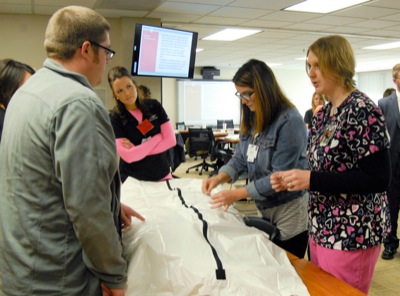Thursday, April 14th, 2016
Grey: Bones found at Grand Lake may stay mystery
By William Kincaid
CELINA - Six missing people from adjoining states meet the physical description of a potential homicide victim whose remains were found Jan. 3 on state-owned land, east of U.S. 127, in a wooded area along Grand Lake.
However, until investigators link DNA from the bones to that of DNA on file, the case likely will remain unsolved, Mercer County Sheriff Jeff Grey revealed Wednesday afternoon to the newspaper.
"It is important to understand, even if we get DNA, if the DNA is not in a database, it will be difficult, if not impossible, to identify the deceased," Grey said. "Without an identity, this case will be nearly impossible to solve."
County detectives searched the National Missing and Unidentified Person System data bases, specifically in the states of Ohio, Michigan, Indiana, Pennsylvania, West Virginia, Kentucky and Tennessee, Grey said.
They located six people who fit the description of the potential homicide victim, a man of unknown race, ranging in age from 20 to 35 years old and between 5 feet 7 inches and 6 feet 1 inch tall, who went missing in 2015.
"We're in the process right now of contacting each of those states," Grey said, noting detectives are trying to learn as much as they can about each missing person. "We don't know that our person is from one of those states, but we're contacting the state repositories."
Without a DNA match, though, investigators can do little beyond contacting agencies in Ohio and nearby states to compile information about missing people.
The Ohio Bureau of Criminal Investigation's London lab extracted a partial DNA profile from one of the bones.
The partial profile was entered into the FBI's Combined DNA Index System's database to identify the possible homicide victim, but no hits have been made so far, Grey said. Much like a fingerprint, a full DNA profile could improve the chances of a successful search.
Investigators hope to obtain a more exact DNA profile from the University of North Texas. Bones were transported there about two months ago, and the examination is expected to take six months.
"Once we receive their results we will release what information they are able to provide," Grey said.
The university was recommended by forensic anthropologist Dr. Elizabeth Murray of Mount St. Joseph University in Cincinnati, who conducted the preliminary autopsy of the bones and found some to be human and others to be animal, according to Grey.
Asked if detectives have received any other tips or leads, Grey said the department has received a couple of calls from people claiming to have seen vehicles near the recovery site at odd times. However, no one has said anything about suspicious activity or people involved in what is being treated as a homicide case.
Grey said three detectives are working on different aspects of the case as they have time from other duties, Grey said.
"They're doing everything they can until we have an identity (of the victim)," Grey said. "If we identify the person then we'll assign somebody to it full time."
A preliminary autopsy did not determine the cause of death. The skeletal remains likely were placed in the area within the last year, Grey had said. He would not disclose the number or types of bones recovered but noted investigators do not have a complete skeleton.
A woman walking her dog Jan. 3 near state park land, east of U.S. 127, in a wooded area along Grand Lake reportedly found several bones and notified the sheriff's office. The skeletal remains were lying in plain view southeast of the mouth of Coldwater Creek, Grey had said.
Initially, the bones were thought to belong to deer because people sometimes dump the animals' carcasses in the area.
However, some of the bones raised suspicions so officials took them to the Montgomery County Coroner's Office where doctors determined they very likely were human.

